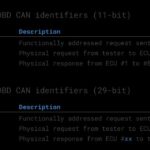The Check Engine Light on your dashboard, often triggered by a diagnostic Fail result from your car’s OBD (On-Board Diagnostics) system, can be a source of worry for any car owner. Recently, we’ve noticed a surge in searches for “OBD,” prompting us, as experts in automotive Engine Management System (EMS) development, to delve deeper into the world of OBD development. Building on our previous discussions about EMS calibration and OBD development, we aim to address a more specific query that has caught our attention: “OBD2 monitoring items.” This indicates a growing interest in the finer details of OBD systems, inspiring us to explore the advanced aspects of OBD further.
*Related Articles*
- Engine Control Development (EMS Calibration)
- Development Items in Engine Control Development
- EMS Development – ③ Automotive OBD Development I
Understanding OBD Diagnostics
The concept of OBD in engine control began in the United States, with California’s stringent regulations, spearheaded by CARB (California Air Resources Board), eventually becoming the federal standard. This pioneering approach to emissions control and diagnostics in the US led to the development of OBD related regulations. Consequently, Europe and other regions began to formulate and adopt their own OBD standards, known as EOBD in Europe and KOBD in Korea.
As we discussed in our earlier post, “OBD Development I,” OBD essentially serves as your car’s internal health monitor. It’s a system designed to assess the operational status of various sensors and actuators within your vehicle, ensuring they are functioning correctly.
Types of Sensors: Throttle Position Sensor (TPS), Oxygen Sensor (O2 Sensor), Accelerator Pedal Position Sensor, Coolant Temperature Sensor, Mass Air Flow Sensor (MAF), Manifold Air Pressure Sensor (MAP), Fuel Level Sensor, and more.
Types of Actuators: Injectors, Ignition Coils, EGR Valve, Evaporative Emission Control Valve, and more.
The Engine Control Module (ECM) relies on accurate signals from these sensors and actuators to perform precise engine control. The fundamental premise is that the information exchanged between the ECM and these components is valid and reliable.
Key Differences: OBD1 vs OBD2
A fundamental distinction in OBD systems lies between OBD1 and OBD2. While sometimes referred to as OBD-I and OBD-II, both notations signify the same generations of on-board diagnostic systems.
The core difference can be simplified as follows: OBD1 primarily focuses on diagnosing sensor and actuator malfunctions, whereas OBD2 extends to diagnosing the performance of these components.
OBD1 is designed to detect basic failures, such as open or short circuits within a component, indicating a complete breakdown. It operates at a rudimentary level, confirming whether a sensor or actuator is fundamentally broken.
In contrast, OBD2 monitors the operational performance of components. It goes beyond simple fault detection to assess whether parts are performing optimally, even if they haven’t completely failed.
For instance, consider fuel impurities that bypass the fuel filter and gradually obstruct the injector nozzle. Even if the ECM sends precise signals, a partially clogged injector will deliver insufficient fuel. OBD2 systems are designed to detect such performance degradation, identifying issues where components are functioning but not meeting performance standards.
Developing OBD1 systems is relatively straightforward because it’s based on binary fault detection – a component is either working (0) or not (1). However, OBD2 development is considerably more complex. It requires defining performance thresholds to differentiate between acceptable and unacceptable performance levels. This necessitates sophisticated software, extensive development time, and significant effort to establish reliable performance diagnostics.
In essence, OBD2 represents a significant advancement in automotive diagnostics, moving beyond basic fault detection to encompass comprehensive performance monitoring, ensuring vehicles operate efficiently and meet stringent emission standards.
